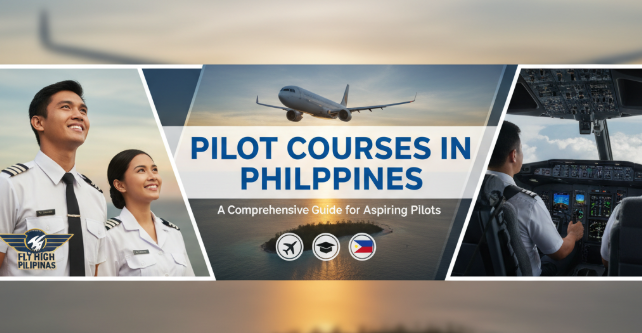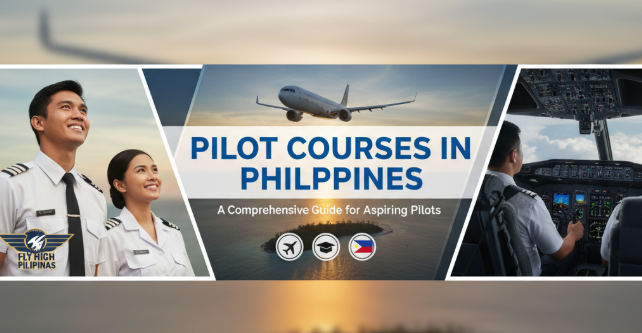
Introduction to Pilot Courses in Philippines
The Philippines, known for its archipelagic landscape and growing aviation sector, has become an attractive destination for aspiring pilots. With a rich aviation history, a booming aviation industry, and numerous training institutes, it offers a solid foundation for those looking to pursue a career in aviation. This guide explores the various pilot courses available in the Philippines, the role of aviation in the country’s development, and the future of pilot training in this rapidly growing industry.
What Does Pilot Program, Flight Academy, and Aviation Institute Mean?
Before diving into the details of pilot courses, it’s important to understand the different educational structures available for aspiring pilots in the Philippines.
- Pilot Program: This generally refers to a structured course designed to train individuals to become certified pilots. These programs often include ground school lessons, flight training, and practical assessments.
- Flight Academy: A flight academy is a dedicated institution that focuses on training pilots, offering both initial and advanced programs. Flight academies provide comprehensive hands-on experience with various aircraft, along with theoretical instruction in aviation theory.
- Aviation Institute: These institutes focus not only on pilot training but also offer courses in other aviation-related fields, such as aircraft maintenance, air traffic control, and aviation management.
These programs aim to create highly qualified aviation professionals by offering specialized training tailored to the needs of the aviation industry.
Importance of Aviation in Philippines
Aviation plays a crucial role in the Philippines’ economy and society. The country’s geographical structure, consisting of more than 7,000 islands, makes air travel a vital component of domestic and international connectivity. Aviation in the Philippines also supports numerous industries, including tourism, trade, and defense.
Economic Significance of Aviation
The Philippine aviation sector contributes significantly to the country’s GDP, providing jobs not only to pilots but also to airport staff, aircraft engineers, air traffic controllers, and support personnel. With more international flights and increasing tourism, the demand for qualified pilots is expected to rise in the coming years.
Connecting Remote Regions
The Philippines’ remote islands rely heavily on aviation for transportation. Small regional airlines and charter flights operate in areas that lack other reliable transportation options. Pilots trained locally play a significant role in ensuring that these connections remain strong and efficient.
History and Development of Aviation in Philippines
Aviation in the Philippines has a fascinating history that reflects the country’s aspirations for modernization and global connectivity. The first recorded flight in the Philippines took place in 1911 when a Filipino aviator, Mariano Y. D., flew a plane across the skies of Manila. This marked the beginning of the Philippines’ journey into the world of aviation.
Early Aviation History of the Country
- Early 20th Century: The Philippines began its foray into aviation through the establishment of local flight schools. The first flight training school, the Philippine Aeronautics School, was founded in 1920.
- World War II: The Philippines’ aviation infrastructure played a crucial role during World War II, with many Filipino pilots serving in the U.S. Army Air Corps.
- Post-War Era: After the war, aviation slowly began to grow as commercial air travel gained momentum, leading to the formation of national carriers like Philippine Airlines (PAL) in 1941.
Milestones in Philippine Aviation
- Formation of PAL (Philippine Airlines): The first commercial airline in the country was founded in 1941, marking the official entry of the Philippines into the global aviation network.
- Airspace Modernization: The government started modernizing aviation infrastructure in the 1970s, including the construction of the Ninoy Aquino International Airport (NAIA) in Manila.
- International Recognition: The Philippines has been recognized globally for its contribution to aviation, particularly in aviation safety standards.
Current Role of Pilot Courses in Philippines
Today, the Philippines has several institutions offering comprehensive pilot courses that are internationally recognized. These courses prepare students for a range of aviation careers, from airline pilots to flight instructors and even specialized roles like air traffic control.
How These Institutions/Programs Function Today
Pilot training in the Philippines has become more advanced with the introduction of high-tech flight simulators, modern aircraft for training, and partnerships with international aviation bodies. Many Filipino pilots are recognized for their expertise in various international aviation sectors, especially in the Middle East and Asia.
Their Role in Civil Aviation, Defense, and Space Exploration
In addition to their role in civil aviation, Filipino pilots are also sought after for defense-related aviation work, with the Philippine Air Force requiring skilled aviators. With the growth of the country’s aerospace interests, such as satellite development and space exploration, pilot training institutions have started to explore advanced aviation technologies like space tourism and drone operations.
Eligibility, Training, and Skills Required
Before aspiring pilots can enroll in pilot courses, they need to meet certain qualifications and complete various training modules.
Basic Qualifications for Pilot Training
- Age Requirements: Typically, students must be at least 17-18 years old to start their training and 21-23 years old to obtain their commercial pilot license (CPL).
- Educational Qualifications: A high school diploma is usually required, but a college degree in aviation, engineering, or a related field can be advantageous.
- Health Requirements: A valid medical certificate is essential to ensure that prospective pilots are physically fit for the demands of flight training. The Philippines follows international aviation medical standards.
Technical and Soft Skills for Aspiring Pilots
- Technical Skills: These include understanding aerodynamics, navigation, meteorology, and flight planning. Pilots need to be familiar with the technical operations of different aircraft types and air traffic control procedures.
- Soft Skills: Leadership, decision-making, communication, and problem-solving are crucial. Pilots must be able to perform under pressure, handle stressful situations, and work effectively in teams.
Institutes, Academies, and Training Centers in Philippines
The Philippines is home to several reputable aviation schools, offering a wide range of pilot courses.
Major Aviation Academies in the Philippines
- Philippine Aeronautical Training Institute (PATI) – One of the oldest and most recognized flight schools in the Philippines.
- Cebu Pacific Air Pilot Training Academy – Offers both private and commercial pilot licenses.
- Aviation School of the Philippines (ASP) – Known for its advanced pilot training programs and modern aircraft fleet.
- Mindanao State University – Institute of Aviation (MSU-IA) – Offers pilot training in collaboration with international aviation bodies.
- Airlink International Aviation College – Known for providing comprehensive flight training, including multi-engine and instrument ratings.
Government Initiatives for Aviation Training
In addition to these institutions, the government has also played a role in supporting pilot training through the Civil Aviation Authority of the Philippines (CAAP), which regulates aviation safety and training standards.
Technology and Innovation in Aviation Training
With advancements in technology, the Philippines is embracing innovative methods for pilot training.
Flight Simulators and AI in Training
Modern flight simulators, which replicate real-world flying experiences, are a cornerstone of pilot training. These simulators allow trainees to practice emergency situations, navigation, and instrument reading without the risks associated with actual flight.
Digital Cockpits and Spacecraft Navigation
Digital cockpits and AI-assisted systems are becoming integral to pilot training. These systems provide real-time feedback and improve pilot decision-making skills. In line with global advancements, Filipino pilot academies are incorporating these innovations into their training programs.
Space Exploration: A Global Perspective
The rise of space tourism and satellite launches has shifted the focus of aviation towards the space sector. While the Philippines has not yet developed its own space program, it is looking toward space agencies like NASA, ISRO, and CNSA for inspiration and international collaboration.
Challenges Faced in Pilot Training in Philippines
Despite the opportunities, pilot training in the Philippines faces a few challenges.
Infrastructure Gaps and Costs
While there is no shortage of flight schools, many institutions struggle with outdated infrastructure, limited fleet availability, and high training costs. Aspiring pilots may also find the cost of private lessons and flight hours prohibitive.
Regulatory Hurdles
Training institutions must comply with rigorous international aviation regulations, and maintaining these standards can sometimes pose logistical challenges.
Brain Drain
A significant challenge faced by the Philippines is the migration of trained pilots to foreign countries where aviation opportunities are more abundant.
Future of Pilot Courses in Philippines
The future of pilot courses in the Philippines looks promising, with several trends shaping the direction of the industry.
Space Tourism and Private Aviation
With global interest in space tourism on the rise, pilot training is evolving to include specialized courses in space flight. Additionally, private aviation is expected to see substantial growth in the Philippines.
National Projects and International Collaboration
National projects like the development of advanced satellite systems and collaboration with international space agencies offer a futuristic perspective for the role of Filipino pilots in space exploration.
Career Path and Opportunities
Becoming a pilot in the Philippines involves several steps, including:
- Education: Start with basic education and enroll in a pilot school.
- Private Pilot License (PPL): The first step in your flying career.
- Commercial Pilot License (CPL): After gaining flight hours, you can upgrade to a commercial license.
- Advanced Training: Specialized training for different aircraft, flight instruction, and other aviation-related roles.
- Career Opportunities: Opportunities exist with airlines, cargo carriers, the military, and in space programs.
Salary Expectations
Salaries for pilots vary, but on average, commercial pilots in the Philippines can expect to earn competitive wages, with many seeking opportunities abroad to earn more.
FAQs
How much does pilot training cost in the Philippines?
Pilot training costs can vary depending on the flight school and the type of course. On average, the cost can range from ₱1,000,000 to ₱2,500,000 for a full commercial pilot training course.
Which is the best aviation institute in the Philippines?
There are many reputable aviation schools in the Philippines, such as PATI, Cebu Pacific Air Pilot Training Academy, and the Aviation School of the Philippines.
What qualifications are needed for pilot training in the Philippines?
A high school diploma is required, along with medical clearance and sufficient proficiency in English. A college degree in aviation is advantageous but not mandatory.
Is international flight training available in the Philippines?
Yes, several flight academies in the Philippines offer training that is recognized internationally.
What is the future of aviation in the Philippines?
The future of aviation in the Philippines looks promising with growing demand for pilots, advancements in space travel, and increasing airline activity.
Conclusion
The aviation industry in the Philippines offers a wealth of opportunities for aspiring pilots. Whether you are looking to fly commercially or explore new horizons in space travel, the country’s growing aviation sector can provide the training and skills you need. With world-class pilot schools and a vibrant aviation industry, the Philippines is an ideal destination for those looking to start their aviation careers.
